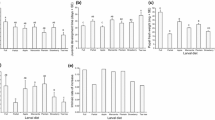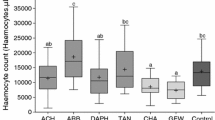Abstract
Some herbivores deliberately consume a mixed diet, either to obtain a superior mix of nutrients or to avoid consuming too much of any one toxin. Few studies have examined diet mixing in parasitic plants, which typically have very broad host ranges. We offered the parasitic plant Cuscuta indecora (dodder), a range of mixtures of two hosts (Iva frutescens and Borrichia frutescens) in the greenhouse, and observed correlations between the host community and Cuscuta infection in the field. In the greenhouse, Cuscuta performed better on mixtures with a higher relative abundance of Iva. Cuscuta selectively foraged on whichever host was more abundant (diet switching), the exact opposite of the behavior that would be expected if diet mixing was advantageous. In the field, the intensity of Cuscuta infections was decreased by the presence of non-hosts (grasses), not strongly affected by the presence of intermediate hosts, and increased by the presence of Borrichia. We conclude that Cuscuta does not obtain nutritional benefits from a broad diet, but instead is constrained by its relative lack of mobility to attack hosts of intermediate value. In general, the lack of mobility of parasitic plants compared to herbivores probably selects for broad host ranges in parasitic plants.




Similar content being viewed by others
References
Agrios (ed) (2005) Plant pathology. Academic Press, San Diego, CA
Atsatt PR (1977) The insect herbivore as a predictive model in parasitic seed plant biology. Am Nat 111:579–612
Atsatt PR (1983) Host–parasite interactions in higher plants. In: Lange OL, Nobel PS, Osmond CB, Ziegler H (eds) Encyclopedia of plant physiology, 12C new series edition. Springer, Berlin, pp 519–535
Atsatt PR, Strong DR (1970) The population biology of annual grassland hemiparasites. I. The host environment. Evolution 24:278–291
Aukema JE, del Rio M (2002) Variation in mistletoe seed deposition: effects of intra- and interspecific host characteristics. Ecography 25:139–144
Behmer ST (2009) Insect herbivore nutrient regulation. Annu Rev Entomol 54:165–187
Bernays E, Graham M (1988) On the evolution of host specificity in phytophagous arthropods. Ecology 69:886–892
Bernays EA, Minkenberg OPJM (1997) Insect herbivores: different reasons for being a generalist. Ecology 78:1157–1169
Bernays EA, Bright K, Howard JJ, Raubenheimer D, Champagne D (1992) Variety is the spice of life: frequent switching between foods in the polyphagous grasshopper Taeniopoda eques Burmeister (Orthoptera: Acrididae). Anim Behav 44:721–731
Bernays EA, Bright KL, Gonzalez AJ (1994) Dietary mixing in a generalist herbivore: tests of two hypotheses. Ecology 75:1997–2006
Callaway RM, Pennings SC (1998) Impact of a parasitic plant on the zonation of two salt marsh perennials. Oecologia 114:100–105
Cameron DD, Coats AM, Seel WE (2006) Differential resistance among host and non-host species underlies the variable success of the hemi-parasitic plant Rhinanthus minor. Ann Bot 98:1289–1299
Chesson J (1983) The estimation and analysis of preference and its relationship to foraging models. Ecology 64:1297–1304
Chuang T-I, Heckard LR (1971) Observations on root-parasitism in Cordylanthus (Scrophulariaceae). Am J Bot 58:218–228
Davies DM, Graves JD (1998) Interactions between arbuscular mycorrhizal fungi and the hemiparasitic angiosperm Rhinanthus minor during co-infection of a host. New Phytol 139:555–563
Freeland WJ, Janzen DH (1974) Strategies in herbivory by mammals, the role of plant secondary compounds. Am Nat 108:269–289
Futuyma DJ, Moreno G (1988) The evolution of ecological specialization. Annu Rev Ecol Syst 19:207–233
Garcia-Rossi D, Rank N, Strong DR (2003) Potential for self-defeating biological control? Variation in herbivore vulnerability among invasive Spartina genotypes. Ecol Appl 13:1640–1649
Gibson CC, Watkinson AR (1989) The host range and selectivity of a parasitic plant: Rhinanthus minor L. Oecologia 78:401–406
Gibson CC, Watkinson AR (1991) Host selectivity and the mediation of competition by the root hemiparasite Rhinanthus minor. Oecologia 86:81–87
Hägele BF, Rowell-Rahier M (1999) Dietary mixing in three generalist herbivores: nutrient complementation or toxin dilution? Oecologia 119:521–533
Hairston NG, Hairston NG (1993) Cause–effect relationships in energy flow, trophic structure, and interspecific interactions. Am Nat 142:379–411
Kelly CK (1990) Plant foraging: a marginal value model and coiling response in Cuscuta subinclusa. Ecology 71:1916–1925
Kelly CK (1992) Resource choice in Cuscuta europaea. Proc Natl Acad Sci 89:12194–12197
Kelly CK, Horning K (1999) Acquisition order and resource value in Cuscuta attenuata. Proc Natl Acad Sci 96:13219–13222
Koch AM, Binder C, Sanders IR (2004) Does the generalist parasitic plant Cuscuta campestris selectively forage in heterogeneous plant communities? New Phytol 162:147–155
Kuijt J (1969) The biology of parasitic plants. University of California Press, Berkeley
Lobel PS, Ogden JC (1981) Foraging by the herbivorous parrotfish Sparisoma radians. Mar Biol 64:173–183
Marvier M (1998) A mixed diet improves performance and herbivore resistance of a parasitic plant. Ecology 79:1272–1280
Matthies D (1996) Interactions between the root hemiparasite Melampyrum arvense and mixtures of host plants: heterotrophic benefit and parasite-mediated competition. Oikos 75:118–124
Matthies D (1998) Influence of the host on growth and biomass allocation in the two facultative root hemiparasites Odontites vulgaris and Euphrasia minima. Flora 193:187–193
Mattson WJ (1980) Herbivory in relation to plant nitrogen content. Annu Rev Ecol Syst 11:119–161
Merz E (1959) Pflanzen und Raupen. Biol Zentralbl 78:152–188
Musselman LJ (1986) The genus Cuscuta in Virginia. Castanea 51(3):188–196
Musselman LJ, Press MC (1995) Introduction to parasitic plants. In: Press MC, Graves JD (eds) Parasitic plants. Chapman and Hall, London, pp 1–13
Pennings SC, Callaway RM (1996) Impact of a parasitic plant on the structure and dynamics of salt marsh vegetation. Ecology 77:1410–1419
Pennings SC, Callaway RM (2002) Parasitic plants: parallels and contrasts with herbivores. Oecologia 131:479–489
Pennings SC, Nadeau MT, Paul VJ (1993) Selectivity and growth of the generalist herbivore Dolabella auricularia feeding upon complementary resources. Ecology 74:879–890
Press MC, Graves JD (1995) Parasitic plants. Chapman and Hall, London
Press MC, Graves JD, Stewart GR (1990) Physiology of the interaction of angiosperm parasites and their higher plant hosts. Plant Cell Environ 13:91–104
Price PW, Bouton CE, Gross P, McPheron BA, Thompson JN, Weis AE (1980) Interactions among three trophic levels: influence of plants on interactions between insect herbivores and natural enemies. Annu Rev Ecol Syst 11:41–65
Pulliam HR (1975) Diet optimization with nutrient constraints. Am Nat 109:765–768
Pyke GH, Pulliam HR, Charnov EL (1977) Optimal foraging: a selective review of theory and tests. Q Rev Biol 52:137–154
Rapport DJ (1980) Optimal foraging for complementary resources. Am Nat 116:324–346
Runyon JB, Mescher MC, De Moreas CM (2006) Volatile chemical cues guide host location and host selection by parasitic plants. Science 313:1964–1967
Salonen V, Setälä H, Puustinen S (2000) The interplay between Pinus sylvestris, its root hemiparasite, Melampyrum pratense, and ectomycorrhizal fungi: influences on plant growth and reproduction. Ecoscience 7:195–200
Sanders IR, Koide RT, Shumway DL (1993) Mycorrhizal stimulation of plant parasitism. Can J Bot 71:1143–1146
Sargent S (1995) Seed fate in a tropical mistletoe: the importance of host twig size. Funct Ecol 9:197–204
Scriber JM (1979) The effects of sequentially switching foodplants upon biomass and nitrogen utilization by polyphagous and stenophagous Papilio larvae. Entomol Exp Appl 25:203–214
Stoyenoff JL, Witter JA, Montgomery ME, Chilcote CA (1994) Effects of host switching on gypsy moth (Lymantria dispar (L.)) under field conditions. Oecologia 97:143–157
Watkinson AR, Gibson CC (1988) Plant parasitism: the population dynamics of parasitic plants and their effects upon plant community structure. In: Davy AJ, Hutchings MJ, Watkinson AR (eds) Plant population ecology. Blackwell Scientific Publications, Oxford, pp 393–411
Watson DM (2009) Determinants of parasitic plant distribution: the role of host quality. Botany 87:16–21
Wiggins NL, McArthur C, Davies NW (2006) Diet switching in a generalist mammalian folivore: fundamental to maximising intake. Oecologia 147:650–657
Acknowledgments
We thank the University of Houston Coastal Center for funding, T. Baragona and L. Wason for field and laboratory assistance, Zhenjiang Lan for teaching us R, and R. Azevedo, W. Rogers, J. Rudgers, R. Zufall and two anonymous reviewers for helpful comments.
Author information
Authors and Affiliations
Corresponding author
Electronic supplementary material
Below is the link to the electronic supplementary material.
Rights and permissions
About this article
Cite this article
Marquardt, E.S., Pennings, S.C. Diet mixing in a parasitic plant: adaptation or constraint?. Plant Ecol 212, 69–77 (2011). https://doi.org/10.1007/s11258-010-9804-z
Received:
Accepted:
Published:
Issue Date:
DOI: https://doi.org/10.1007/s11258-010-9804-z




